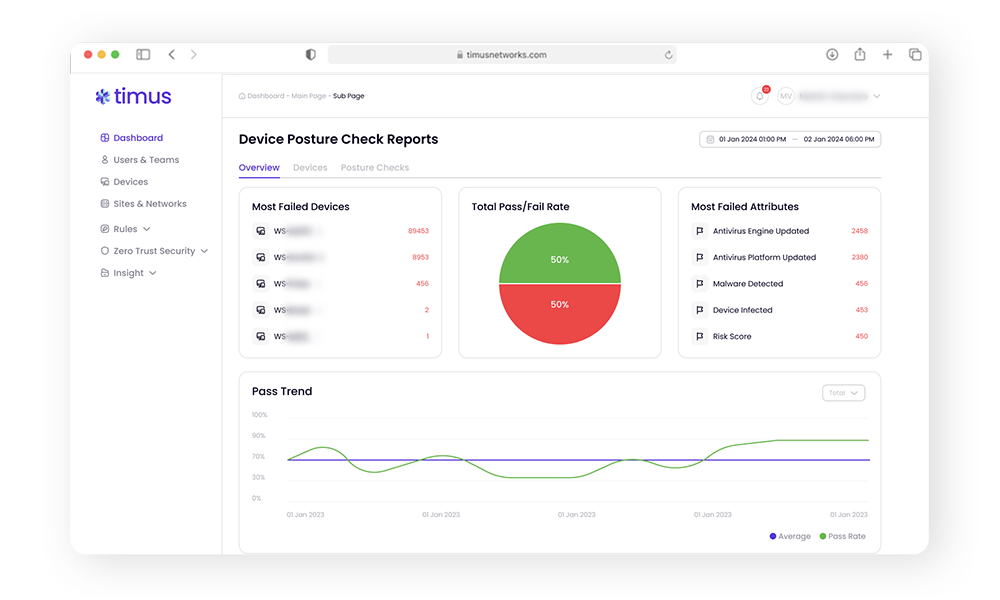Strengthening Network Security: Exploring the Power of Device Posture Check
As the cybersecurity threats have been significantly evolving, they’ve become more sophisticated and capable of bypassing conventional security measures. For organizations across the globe, these developments necessitate a robust strategy to protect their networks from vulnerabilities. A fundamental element in such a strategy is the implementation of Device Posture Checks (DPC), which provides a detailed assessment of each […]
Author
Date
Category
All Categories
- AI-powered security
- Attacks & Threats
- Cybersecurity
- Hybrid Cloud
- Network
- Network Firewall
- Network Protection
- News
- Remote Workforce
- Security
- Zero Trust
Contents
Popular Posts
Product
Join the Newsletter

As the cybersecurity threats have been significantly evolving, they’ve become more sophisticated and capable of bypassing conventional security measures. For organizations across the globe, these developments necessitate a robust strategy to protect their networks from vulnerabilities. A fundamental element in such a strategy is the implementation of Device Posture Checks (DPC), which provides a detailed assessment of each device’s security before it accesses a network. This blog from Timus Networks delves into the intricacies of DPC, underscoring its vital role in modern cybersecurity frameworks.
What is a Device Posture Check?
Device Posture Check (DPC) is a critical process in network security, aimed at evaluating the security configurations and compliance of devices attempting to access a network. The primary goal is to ascertain that these devices adhere to the required security standards, which include having updated antivirus software, deploying active firewalls, and proper encryption mechanisms. By doing so, DPC serves to protect the network from potential threats posed by devices that are not in compliance with security policies, thereby maintaining the overall integrity and security of the IT environment.

How Does a Device Posture Check Work?
Timus Networks employs a state-of-the-art DPC process that is both continuous and automated, seamlessly integrated into the network’s operational framework. This process makes use of data from leading Endpoint Protection Platforms (EPPs) such as BitDefender GravityZone, Microsoft Defender for Endpoint, and Sentinel One XDR, in addition to the data collected by the DPC itself. By leveraging existing security agents already installed on the devices, DPC negates the need for additional software, thereby streamlining the security assessments and enhancing efficiency. The real-time, dynamic assessment of device security posture ensures that only devices meeting stringent security criteria are allowed access, thereby enhancing the network’s security manifold.
The Importance of Device Posture Assessment in Cybersecurity
Continuous security assessments is a cornerstone of DPC. It provides organizations with the ability to monitor and evaluate the security readiness of devices in real-time. This not only helps in ensuring that compliant devices with adequate security measures are granted access but also significantly reduces the attack surface for potential exploits, safeguarding against a wide array of cyber threats, including malware and ransomware.
Benefits of a Device Posture Check
The adoption of DPC brings numerous benefits to an organization’s cybersecurity strategy:
Proactive Threat Mitigation
DPC proactively identifies and blocks non-compliant devices, mitigating the risk of malware, ransomware, and other Advanced Persistent Threats (APTs) by preventing them from gaining access to the network.
Enforced Security Policies
DPC ensures devices comply with pre-defined security standards and organizational policies, minimizing security gaps and improving overall network hygiene. This reduces the attack surface and strengthens the network’s overall security posture.
Conditional Access Implementation
DPC empowers administrators to define granular access control rules based on device posture score and specific attributes. This enables granting full access to compliant devices, restricting access to specific resources for partially compliant devices, and completely blocking access for non-compliant devices. For example, a device with outdated security software or missing critical security patches may be granted limited access to specific resources, while a fully compliant device may have full network access.
Improved Visibility and Control
DPC provides a comprehensive view of all endpoints seeking network access, along with their security posture details (including individual attribute scores and overall compliance status). This enhanced visibility empowers administrators to make informed access control decisions, prioritize remediation efforts for non-compliant devices, gain a deeper understanding of their device inventory, and identify potential security trends.
Continuous Posture Verification
DPC aligns perfectly with Zero Trust principles by continuously verifying the security posture of devices in real-time, ensuring only authorized and trusted devices gain access to network resources. This aligns with the Zero Trust principle of “never trust, always verify.”
Reduced Reliance on Perimeter Security
By focusing on device posture, DPC diminishes dependence on traditional perimeter security measures, which can be bypassed by sophisticated attackers. This reduces the risk of unauthorized access attempts even if attackers manage to breach the perimeter defenses.
Simplified Device Management
DPC streamlines device management by automating security assessments, reducing the manual workload and associated costs for IT teams. Additionally, DPC automates remediation processes for non-compliant devices, further enhancing efficiency.
Enhanced Efficiency in Vulnerability Identification and Response
DPC improves efficiency in identifying and addressing security vulnerabilities associated with non-compliant devices. By providing real-time insights into device posture and automating remediation processes, DPC enables IT teams to prioritize and address vulnerabilities faster, minimizing the window of exposure to potential threats.

Key Components of Timus Device Posture Check
The following features are the critical components of the Timus DPC implementation:
- Continuous Security Assessment: DPC employs a continuous evaluation process to verify the security posture of endpoints (e.g., desktop/laptop computers, mobile devices, tablets) attempting to connect to the network. This real-time assessment provides up-to-date insights into device security readiness, ensuring continuous monitoring and immediate response to potential vulnerabilities.
- Automated Workflows and Remediation: DPC automates various workflows based on pre-defined policies and device posture scores. This includes actions such as quarantining non-compliant devices, sending alerts to IT administrators, and triggering remediation processes (e.g., automatic patch deployment, remote configuration updates) to bring devices into compliance. This automation minimizes manual intervention and ensures timely response to security risks.
- Granular Analysis based on Operating System Families and Attribute-Based Scoring: Tailored to specific operating system families (Windows, macOS, Linux, Android, iOS), DPC performs in-depth analysis based on pre-defined attributes (e.g., security configuration, patch compliance, anti-malware updates, disk encryption status, application whitelisting enforcement). Each attribute is assigned a weighting based on its criticality to overall device security, allowing for a comprehensive score to be generated for each endpoint. This granular approach ensures relevant and impactful security assessments.
- Seamless EPP Integration: DPC leverages existing device data by seamlessly integrating with supported Endpoint Protection Platforms (EPPs), eliminating the need for manual data collection.

Implementing Effective Device Posture Checking Strategies
For effective implementation of DPC, Timus Networks emphasizes the importance of automated workflows that react based on the device posture scores. This includes automating security protocols such as quarantining non-compliant devices and initiating remediation processes like patch deployment, which ensure swift and efficient compliance management.
Securing Your Network: The Role of Device Posture Checks
The strategic implementation of DPC is crucial for maintaining a secure network. It not only enforces stringent security policies per device but also equips administrators with the necessary tools to decisively manage device access, significantly reducing the potential for security breaches.
How Device Posture Checking Improves Operations
Beyond securing networks, DPC also enhances operational efficiency by reducing the manual workload involved in monitoring and assessing device security. This automation allows IT staff to focus on more strategic tasks, ensuring that security standards are upheld without diverting resources from other critical operations.
In conclusion, Timus Networks’ approach to Device Posture Checks not only fortifies network defenses but also ensures that the organization stays ahead of potential cyber threats through proactive security measures. Implementing DPC is essential for any organization aiming to maintain a robust security posture in today’s landscape.
FAQ
A VPN posture check, also called a host checking or endpoint compliance assessment, is a security process used by Virtual Private Networks (VPNs) to evaluate the security status of a device attempting to connect to a network. This check ensures the device meets predefined security criteria before granting access to network resources. Here are the main elements typically involved in a VPN posture check: Security Software Verification: The check might verify that the device has necessary security software installed, such as antivirus programs, firewalls, and anti-spyware. Patch Level Assessment: It assesses whether the operating system and installed applications are up to date with the latest security patches. System Configuration: This check can include evaluating system configurations to ensure they meet specific security standards, such as whether file sharing is disabled, or specific ports are closed. Compliance with Policies: The posture check might ensure the device complies with organizational policies or regulatory requirements. Device Health: It may also look at other aspects of the device’s health, such as detecting potential malware infections or other security vulnerabilities. When a device fails the posture check, access to the network via the VPN can be restricted. This restriction remains until the necessary updates or changes are made to bring the device into compliance. This stringent approach is crucial for maintaining network security and preventing access by potentially compromised devices, underscoring the significance of VPN posture checks in network security.
Calculating an organization’s security posture is a complex process that involves multiple steps and considerations: Asset Discovery and Management: Catalog all IT assets, including hardware and software. Understand what you’re protecting and the data it holds. Vulnerability Assessment: Regularly scan systems, applications, and networks for vulnerabilities. Use tools that provide a comprehensive overview of potential weaknesses. Threat Intelligence: Gather and analyze information about emerging or existing threat actors and their methods. Understand the landscape of potential threats. Risk Assessment: Evaluate the potential impact of identified vulnerabilities and threats on the organization. This should include an assessment of both the likelihood of a security incident and the possible damage it could cause. Security Controls: Review the effectiveness of current security controls and practices. This includes firewalls, intrusion detection systems, encryption, access controls, and security policies. Compliance Standards: Check the organization’s adherence to relevant compliance standards such as GDPR, HIPAA, and PCI-DSS. Incident Response and Management: Assess the organization’s capability to detect, respond to, and recover from security incidents. User Awareness and Training: Evaluate the effectiveness of security training provided to employees. A well-trained workforce can significantly improve your security posture. Benchmarking: Compare your security measures against industry standards and best practices to identify areas for improvement. Security Posture Scoring: Some organizations use scoring models to quantify their security posture. The Common Vulnerability Scoring System (CVSS) provides a way to capture the principal characteristics of a vulnerability and produce a numerical score reflecting its severity. Continuous Monitoring: Security posture is not static; therefore, constant monitoring is required to detect and respond to changes in the organization’s environment. Using the data collected from these activities, an organization can calculate its security posture, often by employing a weighted scoring system where different aspects contribute to an overall security “score.” This score can be tracked to measure improvements or identify areas where the organization is becoming more vulnerable. Security rating services can also provide a score that estimates an organization’s security posture based on various data points. Please note that there isn’t a one-size-fits-all calculation for security posture, as different organizations have different risk tolerances, regulatory requirements, and business objectives. The process is highly individualized and requires expert knowledge to conduct effectively.
Ensuring that a VPN is safe involves several checks and considerations. Here’s a comprehensive approach to evaluating the safety and trustworthiness of a VPN service: Provider Trustworthiness and Policies: · Reputation and user reviews. · Jurisdiction and implications for privacy. · No-logs policy and independent audits. · Transparency and history of handling government requests. Security and Privacy Features: · Encryption standards and secure VPN protocols. · Leak protection, including DNS, WebRTC, and IPv6 leak tests. · Features like a kill switch and options for anonymous payment methods. Performance and Usability: · Speed tests to ensure minimal impact on internet performance. · User interface, experience, and compatibility with different devices. · Customer support responsiveness and quality. Regulatory Compliance and Server Network: · Compliance with global privacy standards and regulations. · Variety and location of servers, considering surveillance laws and exit nodes. Ongoing Maintenance and Community Trust: · Regular updates and maintenance to address vulnerabilities. · Community trust is reflected in forums and feedback from long-term users. Summing up, these categories encompass the critical areas to consider when assessing the safety of a VPN service, including provider trustworthiness and policies, security and privacy features, performance and usability, regulatory compliance and server network, and ongoing maintenance and community trust.
Risk posture, also known as security posture or cybersecurity posture, refers to an organization’s overall cyber risk profile, which is based on its ability to protect its information assets and adequately manage threats that could impact its IT infrastructure. It’s a comprehensive assessment that considers the strength of the organization’s defense mechanisms against cyber threats’ likelihood and potential impact. Here’s what it typically encompasses: Risk Management Strategy: How the organization identifies, assesses, and decides to handle risks. Threat Landscape: The potential threats the organization faces, which could include malware, ransomware, insider threats, and others. Vulnerability Assessment: Current vulnerabilities within the organization’s IT environment that threats could exploit. Impact Analysis: Potential consequences for the organization if its defenses were breached or failed to comply with relevant regulations. Mitigation Efforts: The organization’s actions to reduce risk, such as applying software patches, conducting staff training, and implementing security protocols. Compliance with Regulations: Adherence to laws, regulations, and standards that apply to the organization’s industry and region. Incident Response and Recovery: The organization’s readiness to respond to and recover from security incidents. The risk posture is dynamic and requires ongoing evaluation as new threats emerge, vulnerabilities are discovered, and organizational changes occur. A robust risk posture means an organization has effective security practices and is well-prepared to handle potential cybersecurity incidents, thereby minimizing risk to its operations, reputation, and stakeholders.
Cybersecurity posture sensors are sophisticated software tools that assess and monitor the security status of an organization’s IT ecosystem. They gather data from endpoints, networks, and servers to track system configurations, log files, and network traffic. These sensors then perform vulnerability scans and use threat intelligence to identify and analyze potential cyber threats. By evaluating the severity of these threats and the value of the assets they endanger, the sensors help prioritize risk mitigation efforts. Additionally, these tools ensure compliance with industry regulations and automatically alert IT personnel to security incidents. Many integrate with existing security infrastructure, such as firewalls and SIEM systems, for a holistic security perspective. Advanced systems may even initiate automated responses, like isolating compromised devices, to immediately mitigate risk. This continuous monitoring and assessment is vital for maintaining an organization’s cybersecurity defenses.
Get Started with Timus
Zero Trust. Adaptive Cloud Firewall. Secure Remote Access. In one.
